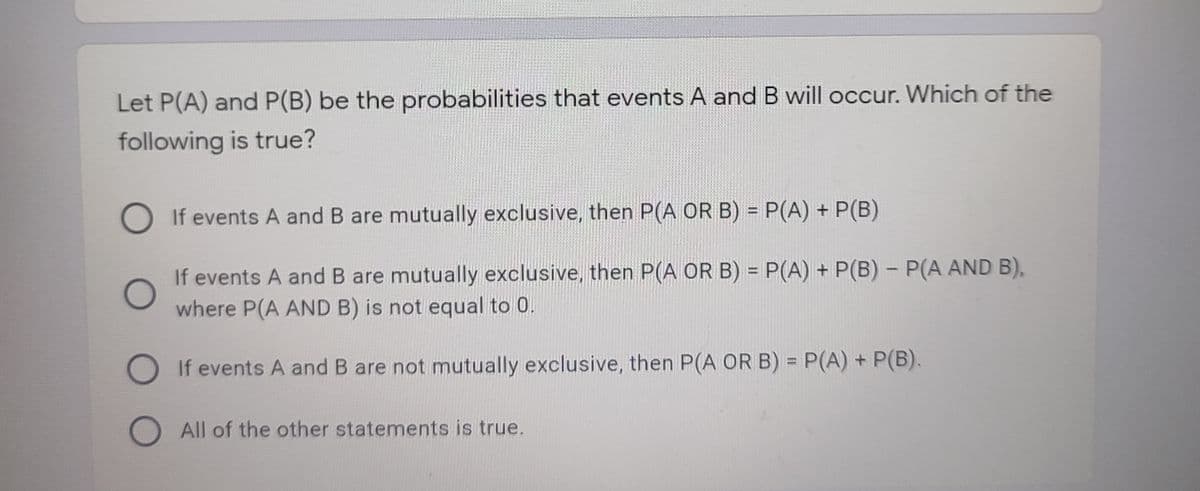Let P(A) and P(B) be the probabilities that events A and B will occur. Which of the following is true? If events A and B are mutually exclusive, then P(A OR B) = P(A) + P(B) %3D If events A and B are mutually exclusive, then P(A OR B) = P(A) + P(B) - P(A AND B), where P(A AND B) is not equal to 0. %3D If events A and B are not mutually exclusive, then P(A OR B) = P(A) + P(B). O All of the other statements is true.
Let P(A) and P(B) be the probabilities that events A and B will occur. Which of the following is true? If events A and B are mutually exclusive, then P(A OR B) = P(A) + P(B) %3D If events A and B are mutually exclusive, then P(A OR B) = P(A) + P(B) - P(A AND B), where P(A AND B) is not equal to 0. %3D If events A and B are not mutually exclusive, then P(A OR B) = P(A) + P(B). O All of the other statements is true.
Holt Mcdougal Larson Pre-algebra: Student Edition 2012
1st Edition
ISBN:9780547587776
Author:HOLT MCDOUGAL
Publisher:HOLT MCDOUGAL
Chapter11: Data Analysis And Probability
Section11.8: Probabilities Of Disjoint And Overlapping Events
Problem 2C
Related questions
Question
Please help

Transcribed Image Text:Let P(A) and P(B) be the probabilities that events A and B will occur. Which of the
following is true?
O If events A and B are mutually exclusive, then P(A OR B) = P(A) + P(B)
%3D
If events A and B are mutually exclusive, then P(A OR B) = P(A) + P(B) - P(A AND B),
where P(A AND B) is not equal to 0.
%3D
O If events A and B are not mutually exclusive, then P(A OR B) = P(A) + P(B).
%3D
O All of the other statements is true.
Expert Solution
This question has been solved!
Explore an expertly crafted, step-by-step solution for a thorough understanding of key concepts.
Step by step
Solved in 2 steps with 2 images

Recommended textbooks for you

Holt Mcdougal Larson Pre-algebra: Student Edition…
Algebra
ISBN:
9780547587776
Author:
HOLT MCDOUGAL
Publisher:
HOLT MCDOUGAL

Holt Mcdougal Larson Pre-algebra: Student Edition…
Algebra
ISBN:
9780547587776
Author:
HOLT MCDOUGAL
Publisher:
HOLT MCDOUGAL